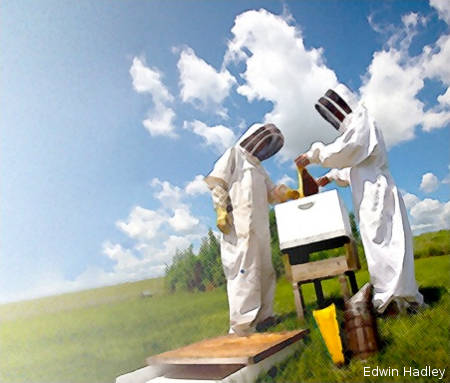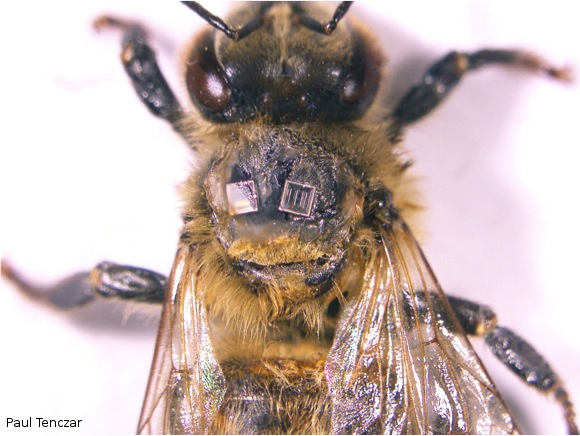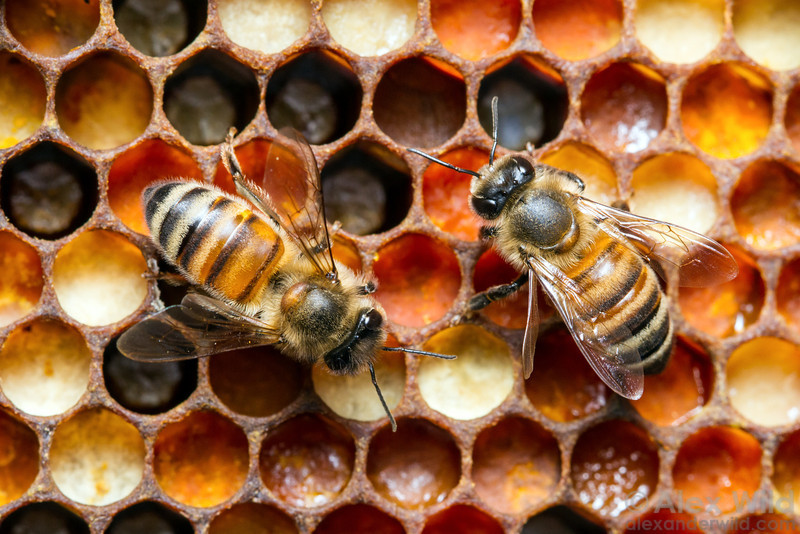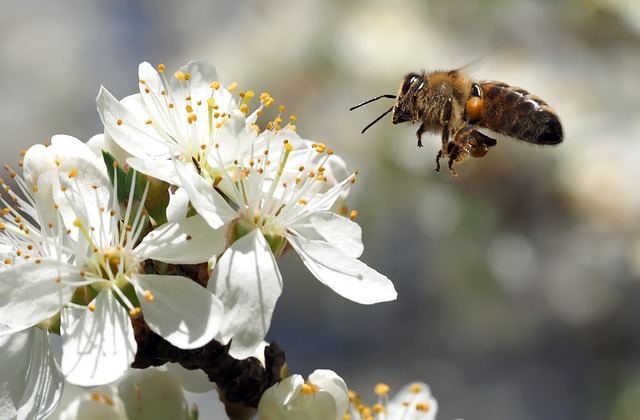Information about the Robinson Lab.
 The Robinson Lab uses the Western honey bee, Apis mellifera, to understand the evolution and mechanisms of social behavior. Among the species of animals, the most attuned to their social environment are the social insects, which include the honey bee. They live in societies that rival our own in complexity and internal cohesion.
The Robinson Lab uses the Western honey bee, Apis mellifera, to understand the evolution and mechanisms of social behavior. Among the species of animals, the most attuned to their social environment are the social insects, which include the honey bee. They live in societies that rival our own in complexity and internal cohesion.
Our goal is to explain the function and evolution of behavioral mechanisms that integrate the activity of individuals in a society, neural and neuroendocrine mechanisms that regulate behavior within the brain of the individual, and the genes that influence social behavior. We focus on the most fundamental social behavior system in the honey bee colony, the division of labor among colony members. We also investigate other behaviors, including dance language, colony defense and reproductive behavior in the usually sterile workers.
Our Principal Investigator is Gene Robinson.
Click the tabs below or visit our website here to learn more.
Background on Social Insects
 Social insects are "eusocial,” which is the most extreme form of animal social life. Bees and other eusocial insects live in colonies with overlapping generations, cooperative brood care, and a reproductive division of labor. The queen reproduces, while the workers perform tasks related to colony growth and development and engage in little, if any, reproduction themselves. Advanced eusocial species such as honey bees have the largest colonies, numbering tens or even hundreds of thousands of workers. They also live in the most complex societies, highlighted by an intricate division of labor among workers. It is this division of labor that has made possible the evolution of traits normally associated with human society: agriculture, warfare, and symbolic language.
Social insects are "eusocial,” which is the most extreme form of animal social life. Bees and other eusocial insects live in colonies with overlapping generations, cooperative brood care, and a reproductive division of labor. The queen reproduces, while the workers perform tasks related to colony growth and development and engage in little, if any, reproduction themselves. Advanced eusocial species such as honey bees have the largest colonies, numbering tens or even hundreds of thousands of workers. They also live in the most complex societies, highlighted by an intricate division of labor among workers. It is this division of labor that has made possible the evolution of traits normally associated with human society: agriculture, warfare, and symbolic language.
Social insects are "extremists" in their constant expression of social behavior. They coordinate virtually all of their activities with other individuals to ensure colony survival. Yet despite their special attributes, the challenges social insects face are not exceptional. All animals must, to some degree, obtain and process information about their changing ecological and social milieu and act accordingly. Neural and behavioral plasticity is even more contingent upon social context for species with active social lives. In social evolution, the sophistication of behavioral mechanisms for the essentials of life--food, shelter, and reproduction--stems from increased abilities to communicate and synchronize behavior with conspecifics. Social insects, especially honey bees, are thus exemplars for the discovery of general principles of brain function, behavior, and social organization.
For Further Reading:
Regulation of Division Of Labor In Insect Societies by G. Robinson
Sociogenomics: Social Life in Molecular Terms by G. Robinson, C. Grozinger, and C. Whitfield
Genes and Social Behavior by G. Robinson, D. Fernald, and D. Clayton
Division of Labor
 Honey bee colonies feature an age-related division of labor. This is based on the behavioral development of the individual worker bee. Behavioral development occurs in many animals, including humans. As animals age and pass through different life stages, their genetically determined behavioral responses to environmental and social stimuli change in predictable ways. Often these responses increase in complexity and involve learning. During just a 4-7 week adult lifespan, worker honey bees display a rich vertebrate-like pattern of behavioral development, which underlies age-related division of labor in the bee colony.
Honey bee colonies feature an age-related division of labor. This is based on the behavioral development of the individual worker bee. Behavioral development occurs in many animals, including humans. As animals age and pass through different life stages, their genetically determined behavioral responses to environmental and social stimuli change in predictable ways. Often these responses increase in complexity and involve learning. During just a 4-7 week adult lifespan, worker honey bees display a rich vertebrate-like pattern of behavioral development, which underlies age-related division of labor in the bee colony.
Bees undergo a series of behavioral transitions. They start out in life working in the hive, caring for the brood, building and maintaining their honeycombs, processing and storing their food, and finally switch to becoming a forager. Foraging is a complex task that requires learning how to navigate in the environment and handle flowers.
Behavioral development in the bee is a powerful system for integrated analysis; although it occurs naturally in the field, some underlying mechanisms also are readily analyzable in the laboratory. Moreover, owing to the bee's special status as a producer of honey and the premier animal pollinator, it has been closely associated with human beings for millennia. As a result, we know more about honey bees than just about any other animal on earth. One consequence of this wealth of knowledge is that the natural social life of the honey bee, though as complex as in any vertebrate society, can be extensively manipulated with unparalleled precision.
For Further Reading:
Division of Labor In Honey Bees Is Associated With Transcriptional Regulatory Plasticity In The Brain by A. Hamilton, I. Traniello, A. Ray, A. Caldwell, S. Wickline, and G. Robinson
Genetic and Genomic Analyses of The Division Of Labour In Insect Societies by C. Smith, A. Toth, A. Suarez, and G. Robinson
Gene Expression Profiles in the Brain Predict Behavior in Individual Honey Bees by C. Whitfield, A-M. Cziko, and G. Robinson
Chemical Communication
 Bees show very structured behavioral development, but they also show a lot of flexibility. They speed up, slow down, or even reversing their trajectories in response to the needs of their colony. How do they do it? Our research, much of it conducted in collaboration with the lab of Dr. Yves LeConte in France, has demonstrated that how fast a bee grows up and becomes a forager is regulated with exquisite complexity, and it depends greatly on chemical communication. We have identified several pheromones that are involved, including a newly discovered pheromone produced by older bees that inhibits behavioral development in younger bees. Genomic analyses have revealed that these pheromones work by regulating brain gene expression.
Bees show very structured behavioral development, but they also show a lot of flexibility. They speed up, slow down, or even reversing their trajectories in response to the needs of their colony. How do they do it? Our research, much of it conducted in collaboration with the lab of Dr. Yves LeConte in France, has demonstrated that how fast a bee grows up and becomes a forager is regulated with exquisite complexity, and it depends greatly on chemical communication. We have identified several pheromones that are involved, including a newly discovered pheromone produced by older bees that inhibits behavioral development in younger bees. Genomic analyses have revealed that these pheromones work by regulating brain gene expression.
For Further Reading:
Pilocarpine Improves Recognition of Nestmates in Young Honey Bees by N. Ismail, S. Christine, G. Robinson, S. Fahrbach
Regulation of Behavioral Maturation by a Primer Pheromone Produced by Adult Worker Honey Bees by I. Leoncini, Y. Conte, G. Costagliola, E. Plettner, A. Toth, M. Wang, Z. Huang, J.-M. Bécard, D. Crauser, K. Slessor, and G. Robinson
Hormonal and Genetic Control of Behavioral Integration in Honey Bee Colonies by G. Robinson, R. Page Jr., C. Strambi, and A. Strambi
Brain Plasticity
How does a bee's brain support the striking changes in behavior that take place during maturation? One part of the answer lies in the mushroom bodies, a brain region that is the center of learning and memory in insects. Together with the laboratory of Prof. Susan Fahrbach, formerly at Illinois and now at Wake Forest University, we discovered about a 20% increase in the volume of a specific area of the mushroom bodies as worker bees mature. This volume increase occurs in a mushroom-body subregion where synapses (connections) are made between neurons from other brain regions that are devoted to sensory input. This was the first report of such brain plasticity in an invertebrate! It was particularly exciting because volume increases in brain regions in vertebrates reflect increases in certain cognitive abilities. The increase in the mushroom bodies might be learning-related.
For Further Reading:
Valence of Social Information Is Encoded In Different Subpopulations of Mushroom Body Kenyon Cells In The Honeybee Brain by I. Traniello, Z. Chen, V. Bagchi, and G. Robinson
Cross-Species Systems Analysis of Evolutionary Toolkits of Neurogenomic Response to Social Challenge by M. Saul, C. Blatti, W. Yang, S. Bukhari, H. Shpigler, J. Troy, C. Seward, L. Sloofman, S. Chandrasekaran, A. Bell, L. Stubbs, G. Robinson, S. Zhao, and S. Sinha
Honey Bee Neurogenomic Responses to Affiliative and Agonistic Social Interactions by H. Shpigler, M. Saul, E. Murdoch, F. Corona, A. Cash-Ahmed, C. Seward, S. Chandrasekaran, L. Stubbs, and G. Robinson.
Molecular Basis of Honey Bee Dance Language
The honey bee is the only non-mammal to have a symbolic language; honey bee dance language shatters our perception of what an insect brain can accomplish and provides a great challenge to discovering how a small brain can generate complex behavior. We use neurochemical and new genomic tools developed in our laboratory and the recently completed honey bee genome to help in this quest. One early breakthrough was the discovery that cocaine, acting on endogenous octopamine pathways, makes bees dance more! Learn more about the waggle dance via the video below.
For Further Reading:
Octopamine Modulates Honey Bee Dance Behavior by A. Barron, R. Maleszka, R. Vander Meer, and G. Robinson
Effects Of Cocaine On Honey Bee Dance Behaviour by A. Barron, R. Maleszka, P. Helliwell, G. Robinson
Central Projections of Sensory Systems Involved in Honey Bee Dance Language Communication by A. Brockmann and G. Robinson
Evolution of Insect Societies In Molecular Terms
 Social insects live in extraordinarily complex and cohesive societies, where many individuals sacrifice their personal reproduction to become helpers in the colony. Identifying adaptive molecular changes involved in eusocial evolution in insects is important for understanding the mechanisms underlying transitions from solitary to social living, and the maintenance and elaboration of social life. We develop large-scale genomic resources to address these issues, in wasps and bees. These resources include brain transcriptomes and whole genomes. Drawing from whole-genome comparisons, candidate gene approaches, and a genome-scale, comparative analysis of protein-coding sequence, we have made novel discoveries related to several major biological processes, including chemical signaling, brain development and function, reproduction, and metabolism and nutrition. Working with the Beijing Genome Institute we sequenced and analyzed genomes for 10 species that show different levels of sociality, and found evidence that gene regulatory networks have become more complex during social evolution.
Social insects live in extraordinarily complex and cohesive societies, where many individuals sacrifice their personal reproduction to become helpers in the colony. Identifying adaptive molecular changes involved in eusocial evolution in insects is important for understanding the mechanisms underlying transitions from solitary to social living, and the maintenance and elaboration of social life. We develop large-scale genomic resources to address these issues, in wasps and bees. These resources include brain transcriptomes and whole genomes. Drawing from whole-genome comparisons, candidate gene approaches, and a genome-scale, comparative analysis of protein-coding sequence, we have made novel discoveries related to several major biological processes, including chemical signaling, brain development and function, reproduction, and metabolism and nutrition. Working with the Beijing Genome Institute we sequenced and analyzed genomes for 10 species that show different levels of sociality, and found evidence that gene regulatory networks have become more complex during social evolution.
For Further Reading:
Caste-Biased Gene Expression in a Facultatively Eusocial Bee Suggests a Role for Genetic Accommodation in the Evolution of Eusociality by B. Jones, C. Kingwell, W. Wcislo and G. Robinson
Genetic Accommodation and the Role of Ancestral Plasticity in the Evolution of Insect Eusociality by B. Jones and G. Robinson
Genomic Signatures of Evolutionary Transitions from Solitary to Group Living by K. Kapheim, H. Robertson, M. Hudson, A. Venkat, B. Fischman, J. Massey, C. Blatti III, S. Sinha, G. Robinson, and Others from Across the World